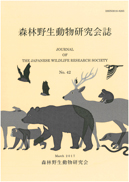Volume 44
Displaying 1-10 of 10 articles from this issue
- |<
- <
- 1
- >
- >|
Original article
-
2019Volume 44 Pages 1-7
Published: March 31, 2019
Released on J-STAGE: May 02, 2023
Download PDF (1793K)
Short communications
-
2019Volume 44 Pages 9-13
Published: March 31, 2019
Released on J-STAGE: May 02, 2023
Download PDF (663K)
Materials
-
2019Volume 44 Pages 15-20
Published: March 31, 2019
Released on J-STAGE: May 02, 2023
Download PDF (907K) -
2019Volume 44 Pages 21-33
Published: March 31, 2019
Released on J-STAGE: May 02, 2023
Download PDF (975K) -
2019Volume 44 Pages 35-41
Published: March 31, 2019
Released on J-STAGE: May 02, 2023
Download PDF (2199K)
Reports on the open symposium “Wild Mammals and Birds and Their Conservation in Tokyo”
-
2019Volume 44 Pages 43-44
Published: March 31, 2019
Released on J-STAGE: May 02, 2023
Download PDF (167K) -
2019Volume 44 Pages 45-49
Published: March 31, 2019
Released on J-STAGE: May 02, 2023
Download PDF (313K) -
2019Volume 44 Pages 51-55
Published: March 31, 2019
Released on J-STAGE: May 02, 2023
Download PDF (1988K) -
2019Volume 44 Pages 57-63
Published: March 31, 2019
Released on J-STAGE: May 02, 2023
Download PDF (2630K) -
2019Volume 44 Pages 65-72
Published: March 31, 2019
Released on J-STAGE: May 02, 2023
Download PDF (1588K)
- |<
- <
- 1
- >
- >|
